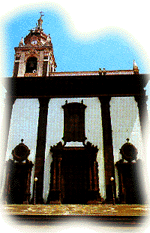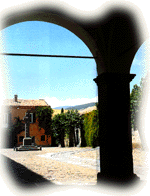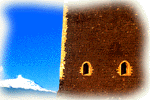 |


|
|
THE HIGHEST VOLCANO IN EUROPE |
|
| Proceeding east and then north-west from Nicolosi, one can easily set out to discover the civilisation of the mountain people. Founded towards the year 1200 around the Benedectine convent of St. Nicholas, Nicolosi is known as the Gateway to Etna and is well equipped with tourist facilities. The road from Nicolosi leads to Pedara, a small town that has grown up on the site of an ancient Greek-Sicilian settlement. Originally called Lapidaria, the town is close to large stone quarries which contrast with the age-old pinewoods of Tarderia nearby. The road leads on to Trecastagni, S.Alfio, Zafferena Etnea and Linguarossa, almost within walking distance of one another. Trecastagni is dominated by a magnificent baroque cathedral: an unusual flight of steps leads up to it, with an irregular geometrical pattern that appears to hide ancient esoteric secrets. The roads and houses are decorated with joyful floral Liberty designs, while the restful green of the cedars contrasts with the sun-scorched broom. Localities like Viagrande in this area were favourite holiday resorts for the nobility of Mount Etna. The Biscari, Paterṇ and Emmanuel families built their magnificent houses here, while the Evelines - representing the rich Anglo-Sicilian middle class - preferred Zafferana Etnea where one can still see their fine villa, now public property, perfectly conserved in the midst of palms and magnolias. A visit to S.Alfio is obligatory for those who wish to see the incredible natural phenomenon of the millenary chestnut tree of a hundred horses. According to an ancient legend, Queen Joan of Anjou found refuge under its branches during a storm, along with her retinue of a hundred knights and horses. Linguaglossa, the most famous ski resort in Sicily, marks the beginning of the itinerary north-west along the slopes of Etna. 20 km of ski slopes start from Piano Provenzano, equipped with modern skilifts leading up to a height of 1,880 metres. Skiers are provided with first-class services while CAI (the Italian Alpine Club) provides aid for those who wish to accept the challenge of climbing up to the summit of the volcano. After a visit to the attractive Medieval town of Castiglione di Sicilia, renowned for its lace and its castle with elegant 14th century million windows, the route takes us on to Randazzo on the western side of the mountain. Legend has it that this town where different races have mixed in harmony over the centuries was founded by the giant Piracomone, with the help of his brothers, Bronte and Sterpe. Greeks, Romans, Normans, Swabians, Anjouans, Aragonese and Longobards have all left their mark on this town, on the people and their language, and the various influence can still be seen today. The wealth of the local architecture - diversified between pure Medieval, Swabian, baroque and Aragonese styles - is due to the fact that Randazzo was once a point of transit and resting place for the silk caravans which travelled from Palermo to Messina along the island's rough internal roads in order to avoid attacks from Saracen pirates who used to invade the Tyrrhenian coasts of Sicily. Charles V stopped at Randazzo in 1536: fascinated by the town's beauty, he left funds and donations to enrich the splendid church of St. Nicholas which, along with the Swabian basilica of St. Mary and St. Martin's church, adds a majestic touch to this exquisite town. A few miles from here we come to Bronte, situated at the top of a steep slope facing the Simeto valley. Well known for the production of pistachio, the town is perhaps even more famous for its connections with Admiral Nelson. Ferdinand III, the last Bourbon king of Sicily, donated the hero of Abukir with the Maniace estate with its magnificent park and castle on which the Union Jack still flew until a few years ago, when the town bought the property from the Admiral's heirs. At Adrano we can find a compendium of all the civilisations that have succeeded one another in the area over the years at the Archeological Museum, which testifies to 5,000 years of the town's history. Adrano had a democratic government as early as 344 B.B. when Timoleonte led the population to independence; they minted their own coins and developed trade and commerce, before being subjected to the domination of Siracusa, followed by that of Pirro and conquest by Messala's Roman legions. After Byzantine and Arab rule, the town became part of the Norman kingdom and in 1070 Adrano was made into a county by Count Ruggero who handed it over to his nephew Adelassia. The construction of the castle which today houses the Archeological Museum, dates back to that period. But the town's fascination lies in the variety of its aspects: the elegance of Renaissance architecture mitigates the pomp of the baroque buildings, while the large parks provide rest for one's eyes in contemplating all the vegetation's shades of colour. Out itinerary comes to a conclusione at Paterṇ, the ancient Hybla Major, also known as "The Fertile Town", and we prepare to descend into the Simeto alluvional valley - where the splendid Catania plain is now situated - towards the Calatino area. Behind us we leave another menacing Norman castle dominating the plain from Paterṇ: it is a huge parallelepiped of lava rock, without towers or ramparts, whose compact walls are only broken up by the assymetrical windows. Here Queen Bianca of Navarra decreed her laws while in another impregnable castle, at Motta S.Anastasia, just a few miles away, her faithful admiral, Sanho Ruys de Rihori, kept prisoner the kingdom's old and proud executioner, Bernardo Cabrera, who, by combining the motivations of the heart with those of power, had dared aspire to the throne of Sicily.
|
||




